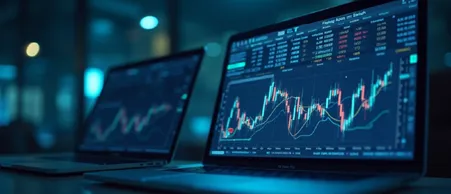What is Secondary Market: A comprehensive guide


The financial world is composed of several interconnected platforms where investors buy and sell securities. Among these, the secondary market stands out as a crucial arena for continuous trading after securities have been issued.
This article offers a detailed overview of the secondary market, shedding light on its meaning, examples, categories, mechanism, advantages, and challenges.
- Table of contents
- Understanding the secondary market
- Examples of secondary market transactions
- Types of financial instruments in the secondary market
- Categories of the secondary market
- Role of regulators in secondary markets
- How secondary market works
- Advantages of the secondary market
- Challenges of the secondary market
- Impact of secondary markets on mutual funds
Understanding the secondary market
To grasp the secondary market meaning, it is essential to contrast it with the primary market. In the primary market, new securities are issued to investors for the first time, typically through processes such as Initial Public Offerings (IPOs). In contrast, the secondary market is the platform where existing securities are traded among investors after their initial issuance.
When investors wonder, “What is secondary market and why is it so pivotal?”, the answer lies in its critical function of enabling trading, investing and capital circulation without the issuing entity receiving any further capital. This means that once a company’s shares are released in the primary market, all subsequent transactions of those shares occur in the secondary market.
Consequently, the secondary market offers flexibility and liquidity to investors, making it a mainstay of modern financial ecosystems.
Read Also: Stock Market Trading: Meaning, Types, and Historical Context
Examples of secondary market transactions
Real-world secondary market examples often revolve around the stock exchange. Suppose you purchase shares of a well-known company from another individual through a recognised stock exchange. Here, your trade is part of the secondary market, because you are buying shares that already exist.
Another example can be found in bond trading. Governments or corporations issue bonds to raise funds in the primary market. Once these bonds are in circulation, they can be bought and sold multiple times by various investors in the secondary market.
Similarly, mutual fund units (especially exchange traded funds or ETFs) can trade on the exchange if the scheme is listed. Although most mutual fund dealings happen directly with the asset management company, certain listed funds (such as close-ended and interval funds) can also facilitate secondary market transactions.
Types of financial instruments in the secondary market
- Stocks: These represent ownership in a company. Once issued, they are actively traded on exchanges worldwide.
- Bonds: Government bodies and corporations issue debt securities in the primary market, which later appear in the secondary market for regular trading.
- Derivatives: Futures and options fall under this category. They derive their value from an underlying asset, such as stocks, commodities, or currencies, and are actively traded on secondary market platforms.
- Exchange-traded funds (ETFs): These funds track a basket of assets like an index or commodity and can be traded on exchanges like stocks.
- Preference shares: Although not as frequently traded as common stock, preference shares also change hands in the secondary market, offering investors potential dividends and a more predictable income stream.
Categories of the secondary market
When people search for “Types of Secondary Market ” they often refer to the following two broad segments.
- Stock exchange: This category denotes an organised marketplace where shares, bonds, and other securities are bought and sold under strict regulations. Most investors participate through stock exchanges due to their transparent operations and standardised processes.
- Over-the-counter (OTC) market: In this category, trades happen outside formal exchanges. Dealers negotiate prices directly with buyers. OTC markets often handle less standardised securities like certain types of derivatives or smaller company stocks.
Role of regulators in the secondary market
The role of regulators in the secondary market is crucial, as they ensure transparency and safeguard investor interests. In India, the Securities and Exchange Board of India (SEBI) is the primary regulator overseeing stock market activities. Its responsibilities include framing rules for trading, supervising intermediaries and exchanges, monitoring transactions, and taking action against fraudulent or unfair practices. Regulators also require listed companies to make timely and accurate disclosures, which helps maintain market integrity and informed decision-making. By enforcing compliance with regulations, SEBI helps build investor confidence in the secondary market, thereby supporting its smooth functioning and efficient capital allocation.
How secondary market works
In the secondary market, trades happen between investors, not directly the issuing entity. Listed securities have a designated ticker on an exchange, allowing participants to place orders through brokers or digital trading platforms. Here are the steps followed:
- Once an order is placed, it enters the market where a matching process occurs.
- For example, if you want to buy 100 shares at a certain price, the system locates a seller offering shares.
- If the criteria aligns, the transaction is completed electronically within seconds.
- The funds move from buyer to seller, and the shares transfer ownership accordingly.
Regulatory bodies like the Securities and Exchange Board of India (SEBI) oversee the process, ensuring fair practices and transparency. This mechanism enables quick, efficient, and liquid trading for a variety of securities.
Advantages of the secondary market
- Liquidity: Investors can buy or sell their holdings, transforming assets into cash.
- Price discovery: With continuous trading and participation from numerous buyers and sellers, the secondary market reflects fair prices driven by real-time supply and demand.
- Flexibility: Investors may rebalance or diversify portfolios swiftly, responding to market fluctuations or personal financial goals.
- Accessibility: A growing number of brokerage platforms have expanded reach, making the secondary market open to a broader audience.
- Informed decision-making: With a regular flow of information, including company news and market data, traders can make decisions aligned with their risk tolerance.
Challenges of the secondary market
- Volatility: Prices can swing rapidly, driven by geopolitical events, corporate announcements, or broad economic trends. Such volatility may lead to emotional trading decisions.
- Market manipulation: Unscrupulous players may attempt to influence prices through deceptive practices. While regulators like SEBI diligently monitor activities, risks persist.
- Information overload: Amid 24/7 news cycles and countless data points, distinguishing between relevant and misleading information can be difficult.
- Transaction costs: Brokerage fees, taxes, and other charges can accumulate, especially for active traders, impacting overall returns.
- Systematic risks: Events like major policy changes or financial crises can affect the entire market, leading to rapid and widespread valuation shifts that are difficult to predict or manage.
Read Also: What is Stock Market Crash? Meaning and Tips to Manage
Impact of secondary market on mutual funds
The secondary market plays an integral role in the mutual fund industry since fund managers invest in stocks and other securities traded there. Fluctuations in prices of stocks or bonds affect the Net Asset Value (NAV) of mutual funds. When the markets are growing and liquidity is high, fund managers can make potential gains and buy and sell securities efficiently. Market trends, investor sentiment, and overall liquidity also shape the returns of mutual funds. Additionally, price discovery in the secondary market helps mutual funds assess the fair value of their holdings. Thus, the secondary market plays a vital role in determining potential risks and returns for mutual fund investors.
Conclusion
In summary, the secondary market is fundamental to the financial ecosystem, enabling seamless trading, price discovery, and increased investor confidence. By offering a platform where previously issued securities can be actively traded, it serves as a conduit for liquidity and growth. Although the secondary market presents challenges like volatility and potential manipulation, proper research and regulatory safeguards help mitigate risks. For investors in mutual funds, secondary market trends can indirectly impact net asset values, especially when funds hold stocks or bonds that fluctuate in price. When investing in mutual funds under regular plans, it is advisable to do so through distributors who can offer guidance.
FAQs:
What is the secondary market?
The secondary market is a financial marketplace where investors buy and sell existing securities, such as stocks or bonds, after their initial issuance in the primary market.
What are the different categories of the secondary market?
Broadly, the secondary market is divided into two categories: the stock exchange, an organised venue with standardised trading procedures, and the over-the-counter (OTC) market, where trades are negotiated directly between parties.
How does the secondary market differ from the primary market?
In the primary market, securities are issued for the first time and capital goes to the issuing company or entity. In the secondary market, trading occurs among investors, and no fresh capital is raised for issuers.
How are prices determined in the secondary market?
Prices are influenced by supply and demand, investor sentiment, and global economic factors. Continuous trading activity ensures ongoing price discovery.
What is SEBI’s role in the secondary market?
SEBI regulates and supervises India’s secondary market to maintain fairness, transparency, and efficiency. It implements guidelines, monitors trading activities, and takes enforcement actions if needed.
Mutual Fund investments are subject to market risks, read all scheme related documents carefully.
This document should not be treated as endorsement of the views/opinions or as investment advice. This document should not be construed as a research report or a recommendation to buy or sell any security. This document is for information purpose only and should not be construed as a promise on minimum returns or safeguard of capital. This document alone is not sufficient and should not be used for the development or implementation of an investment strategy. The recipient should note and understand that the information provided above may not contain all the material aspects relevant for making an investment decision. Investors are advised to consult their own investment advisor before making any investment decision in light of their risk appetite, investment goals and horizon. This information is subject to change without any prior notice.
The content herein has been prepared on the basis of publicly available information believed to be reliable. However, Bajaj Finserv Asset Management Ltd. does not guarantee the accuracy of such information, assure its completeness or warrant such information will not be changed. The tax information (if any) in this article is based on prevailing laws at the time of publishing the article and is subject to change. Please consult a tax professional or refer to the latest regulations for up-to-date information.